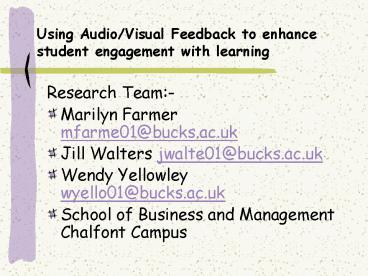Using AudioVisual Feedback to enhance student engagement with learning - PowerPoint PPT Presentation
1 / 11
Title:
Using AudioVisual Feedback to enhance student engagement with learning
Description:
Using Audio/Visual Feedback to enhance student engagement with learning. Research Team: ... 'It was easy to miss a point made' ... – PowerPoint PPT presentation
Number of Views:186
Avg rating:3.0/5.0
Title: Using AudioVisual Feedback to enhance student engagement with learning
1
Using Audio/Visual Feedback to enhance student
engagement with learning
- Research Team-
- Marilyn Farmer mfarme01_at_bucks.ac.uk
- Jill Walters jwalte01_at_bucks.ac.uk
- Wendy Yellowley wyello01_at_bucks.ac.uk
- School of Business and Management Chalfont Campus
2
Feedback?
- Crucial for student learning
- Difficult to get right
- Complex range of perceptions from students and
tutors about its role - Negative perceptions of feedback in national
student survey - Research evidence
- Our research project
3
Research project
- LEP funded
- Aim to explore impact on engagement and student
learning of - audio-visual feedback
- Objectives
- To identify, design and develop an audio-visual
approach to providing feedback including pod
casts, videos and DVDs - To utilise the feedback and feed forward
opportunities in lectures and on the VLE - To assess the impact of the feedback on student
learning through questionnaires and interviews - To evaluate the findings and to make
recommendations on the role of audio-visual
feedback on student learning
4
What does the literature tell us?
- We tend to allocate more time and resources to
the transmission of content than to thinking
about assessment and feedback (Price and
ODonovan, 2008) - The learners experience of evaluation and
assessment determines the way in which the
student approaches (future) learning (Entwistle,
1991 cited by Struyven et al, 2005) - Students often dont read their feedback, nor do
they understand it (Gibbs and Simpson, 2002) - It cannot simply be assumed that when students
are given feedback they will know what to do
with it (Rust et al, 2005)
5
Social Constructivist Model
- Students need to understand clearly what
constitutes a good piece of work - Tutors need to share a common understanding of
the explicit and implicit criteria - Important to create a dialogue between staff and
students, students and students, staff and staff - A dialogue can also help to de-mystify the
academic jargon - A social constructivist view of learning argues
that knowledge is shaped and evolves through
increasing participation within different
communities of practice. (Rust et al, 2005)
6
Challenges to feedback
- Large groups
- Widening participation and diversity
- Availability of tutors
- Instrumentality of students
- Modular structure
- Consistency across teaching teams
- Timing
- Anonymous marking
7
What have we found so far?
- You can listen to it and watch the
expressionsit helped me to understand the
assignment and things to avoid - The fact that you can watch as well as listen
doesnt allow your mind to wander as much - Its something new and it feels like a modern
approach - I thought it was great- you can listen to the
points of views of both students/lecturers. You
can also listen again and again - It was useful to hear what students thought
instead of what lecturers tell us. We can relate
to them and learn from their mistakes
8
A taste of the negatives
- It was more generic
- It was easy to miss a point made
- The moving background was hypnotic and made me
sleepy - lost concentration - The commentary was good but the visuals were
distracting
9
Thoughts for the future
- Powerful feedback approach which can engage
students in reflection and the process of
learning - Audio visual feedback can de-mystify the jargon
and supports the transfer of tacit knowledge and
meaningful understanding - Audio visual feedback seems to appeal to
students in the digital age enabling Just in
Time learning - Additional dimension to support diverse learners
- Facilitates wider feedback and learning from role
models (peers and employers) - Available, flexible, accessible
10
Moving forward
- Ongoing research and a paper for publication will
be prepared - Conference session and paper to be presented at
16th International Conference on Learning, July
2009
11
Thank you for listening
- How do you engage students in understanding
assessment requirements and learning from
feedback?































